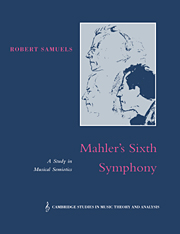Book contents
4 - Genre and presupposition in the Mahlerian scherzo
Published online by Cambridge University Press: 17 November 2009
Summary
‘Scherzo’ was by no means an automatic inscription for Mahler at the head of a symphonic movement, as Constantin Floros observes (1977-85, vol. 2: 165). If in the Sixth Symphony this invocation of convention has a polemical edge, the nature of this polemic must be sought on several different levels. Firstly, the movement title underlines the decision to embrace the four-movement symphonic schema of allegro, scherzo, slow movement and finale. More importantly, the etymology of ‘scherzo’ suggests a distortion of generic type (in its original speeding up of a minuet); a latent expectation which is always the occasion for irony and parody in Mahler's denoted scherzos. Finally, a scherzo involves dance forms, which in this symphony (and generally in Mahler) enlarge the scope of the music beyond those dance genres normally associated with symphonic practice – minuet and so forth – to those from outside the realm of ‘art music’, specifically the waltz, ländler, and Bohemian folk-dances.
This is not to say very much; but in order to investigate the semiotic specificity of this movement, and to try to bring some analytical justification to slippery signifieds such as irony or parody, the concept of the code must be broadened beyond the consideration of structures immanent to the music and identifiable as patterns within the graphic text which is the work's transmitted material form.
The question of genre is one which introduces the social and cultural context of the composition to the analysis.
- Type
- Chapter
- Information
- Mahler's Sixth SymphonyA Study in Musical Semiotics, pp. 91 - 132Publisher: Cambridge University PressPrint publication year: 1995



